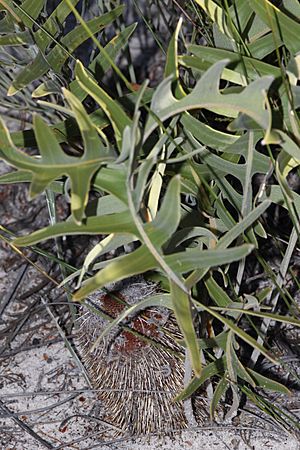Fishbone banksia facts for kids
Quick facts for kids Fishbone banksia |
|
|---|---|
 |
|
| Banksia chamaephyton with rather old flower spike at Alexander Morrison National Park, Western Australia | |
| Conservation status | |
| Scientific classification | |
| Genus: |
Banksia
|
| Species: |
chamaephyton
|
The Banksia chamaephyton, commonly called the fishbone banksia, is a unique shrub. It grows only in Western Australia. This plant has stems that lie flat or grow underground. Its leaves are deeply divided, looking a bit like a fishbone. It has cream-coloured and brown flowers that grow in spikes. These spikes are surrounded by fuzzy leaf-like parts called bracts. You can find it growing in a special type of shrubland called kwongan, near the lower west coast.
Contents
What Does It Look Like?
The fishbone banksia is a shrub that usually grows to about 0.4 meters (about 1.3 feet) tall. It can spread out to about 2 meters (about 6.5 feet) wide. This plant has a special woody swelling underground called a lignotuber. This helps it regrow after fires.
Its stems grow flat along the ground or stay underground. They are about 8-12 millimeters (0.3-0.5 inches) thick and are hairy when they are young. The leaves stand upright and are quite long, about 200-500 millimeters (8-20 inches). They are also wide, about 40-160 millimeters (1.5-6 inches). Each leaf has a stalk, called a petiole, which is about 40-210 millimeters (1.5-8 inches) long. The leaves have between ten and thirty thin, finger-like parts on each side. This gives them their "fishbone" look.
The flowers are cream-coloured with brown tips. They grow in a head that is about 60-120 millimeters (2.4-4.7 inches) long. The base of the flower head is surrounded by soft, velvety bracts. The flower's outer parts, called the perianth, are about 23-30 millimeters (0.9-1.2 inches) long. The female part of the flower, called the pistil, is curved and about 25-35 millimeters (1-1.4 inches) long.
This banksia blooms from late October to early December. After flowering, it produces up to fifteen oval-shaped fruits called follicles. Each follicle is about 25-40 millimeters (1-1.6 inches) long, 12-20 millimeters (0.5-0.8 inches) high, and 15-20 millimeters (0.6-0.8 inches) wide. These follicles protect the seeds.
Naming the Fishbone Banksia
The Banksia chamaephyton was first officially described in 1981. A scientist named Alex George found and collected samples of it near Mogumber in 1971.
The second part of its scientific name, chamaephyton, comes from ancient Greek words. "Chamae" means "low-growing," and "phyton" means "plant." This name perfectly describes how this banksia grows close to the ground.
Where Does It Live?
The fishbone banksia grows in a type of shrubland called kwongan. You can find it in Western Australia, in the area between Eneabba and Mogumber.
Protecting the Fishbone Banksia
The Government of Western Australia's Department of Parks and Wildlife has given this banksia a special classification. It is listed as "Priority Four." This means that the plant is rare or nearly threatened. It needs to be watched and protected to make sure it doesn't become endangered.
Growing Fishbone Banksia
If you want to grow a fishbone banksia from seeds, it's quite easy! The seeds don't need any special treatment before planting. They usually start to germinate (sprout) in about 25 days.
- Taylor, Anne; Hopper, Stephen (1988). The Banksia Atlas (Australian Flora and Fauna Series Number 8). Canberra: Australian Government Publishing Service. ISBN 0-644-07124-9.


